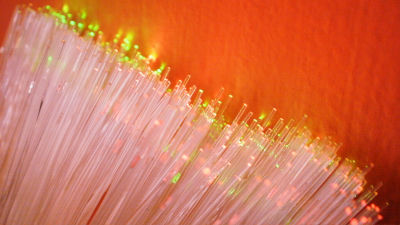Succeeded demonstration experiment with communication speed up to 1.6 Tbps using newly designed optical fiber

ByRoshan Nikam
In June 2012 "With the helical beam communication technology, the communication speed reaches 2.5 Tbps, and in the future there is no need to worry about bandwidth problemsThere was news that Alan E. Willner and others who are studying this communication technology are able to transfer data at 1.6 Tbps by introducing the same technology also for the wired connection using the optical fiber this time The demonstration experiment that it is successful was made.
Terabit-Scale Orbital Angular Momentum Mode Division Multiplexing in Fibers
http://www.sciencemag.org/content/340/6140/1545.abstract

BBC News - 'Twisted light' idea makes for terabit rates in fibre
http://www.bbc.co.uk/news/science-environment-23096320

Alan Willner and colleagues are studyingSpin angular momentum (SAM)To radio waves that have only information onOrbital angular momentum (OAM)By having information of, it enables multiple communications at the same radio frequency. We succeeded in demonstration experiments that transmit and receive by forming a helical beam by adding a twist to the data stream, and its communication speed has become tremendous as 2.5 Tbps (terabits per second).
However, this technology is for wireless communication and can not be brought directly to optical fiber. This is because if the incident signal light becomes too large for the optical fiber, the input is saturated or the waveform is deteriorated, and signal light reduction and optical spectrum change occurNonlinear effectBecause there is. In order to overcome this problem a new idea was necessary.
So, Sddharth Ramachandran from Boston University, co-author of this paper, comes out. Mr. Ramachandran manufactures and sells optical fibers and the likeOFS Fitel(Furukawa Electric, A joint venture company, has created a new design that fibers are contained in the fiber. This new fiber allows you to vary the light speed of each fiber by using different materials for concentric fibers and to give different paths for different beam twists.
In order to try out the new fiber, Mr. Ramachandran joined Mr. Willer's team. The fiber is a special order item with a length of 1.1 km or more, and the connection part is minimized. High-speed data communication is achieved by three-dimensionally combining data multiplexing with individual fibers. In the experiment, data transmission at 400 Gbps was successful with four single wavelength · OAM modes. Also, when using 10 wavelengths and 2 OAM modes, we succeeded in data transfer at 1.6 Tbps.
Currently, the team is advancing research to increase the transmission rate by increasing the wavelength and increasing the twist level (increasing the OMA mode).
However, the fact that it becomes a problem when actually using this new technology is that it is necessary to turn the optical fiber into what used it in the experiment. Optical fibers, which are said to have a total extension of 4 billion km, have already been buried in the ocean floor and underground in the world, and it is not very realistic to replace all these.

However, "Willner may be real if there is a little closed system that requires bandwidth," he said. For example, we propose to use it only in places where terabit communication is required, as in Google's data center.
By the way, NTT · Fujikura · Hokkaido University · Denmark technical university in September 2012Successful transmission experiment of 1 Pbps (1 petabit per second) with one 12-core optical fiberdoing.
Cisco SystemsTotal net traffic will be quadrupled from 2012 to 2016 and will be 1.3 zettaby per yearWe are making a prediction that this technology can help these situations.
Related Posts:
in Note, Posted by logc_nt







